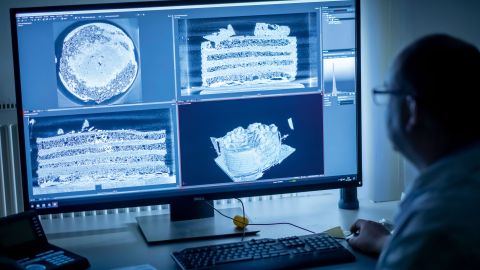A chocolate cream cake as a surprise on the doorstep doesn't always bring joy. Especially when someone is being threatened anonymously and the police have already been called. As a result, the piece of cake made by a pastry chef did not end up on a coffee table, but in a computer tomograph at the Forensic Science and Technology Institute of the State Office of Criminal Investigation in Düsseldorf.
Such a sweet treat as an object of investigation was also new to Mathias Teroerde from sub-department 51.1 (fire/electrical engineering). The trained master electrician operates the high-tech computer tomograph, which was purchased in 2019. He normally uses the two X-ray tubes to examine samples from the fields of fire and electrical engineering, but also weapons, for example. "So this time it's a cake," he says to himself. The 36-year-old doesn't get rattled that quickly: "The basic approach doesn't change." Calm and focused as usual, he got to work, positioned the cake on the sample carrier and started the scanning process.
In a 3D CT scan, the full cone-shaped X-ray beam passes through the rotating object and hits a detector. Several hundred two-dimensional projections are detected and electronic signals are recorded without damaging the object being examined. The computer then creates a three-dimensional image from this.
The computer requires a huge amount of storage capacity for such a 3D reconstruction - between 15 and 45 gigabytes. However, such models are particularly vivid and informative. This is also the case here.
Teroerde points to the middle of the 3D representation in shades of gray. There is a circular spot, almost hidden by a chocolate tile. "That's the puncture hole," says Teroerde. He then points to a 2D section. "The otherwise loose structure of the dessert suddenly appears whitish and denser at the edge. A clear indication of an injected material."
The CT images helped the toxicologists to further investigate the case. There, analytical tests revealed that a strong sedative had been added to the baked goods.
During Teroerde's presentation, a colleague from the LKA comes in. Weapons specialist Felix Baum is a qualified mechanical engineer and is happy to make use of the CT's services. He has handed the technician a pistol for examination that used to be sharp and may have been rendered unusable at some point.
The gun was found at an "old customer". Baum examined the gun and found it to be fit to fire. Due to anomalies on visible surfaces, for example in the form of light clouds, the structure of the material is to be checked non-destructively and recorded in the image before the functional test is carried out. "Such anomalies occur more frequently here," he explains.
And that's right. The computer tomograph has provided proof. Among other things, a new barrel has been welded in, very good and almost invisible. "X-ray eyes see more," remarks Felix Baum with satisfaction and takes his leave. The results are included in the expert report, so there is no question about the way the conversion was carried out.
The CT is operated by the fire experts and has proven its worth in investigating the causes of fires. For example, a restaurant caught fire some time ago. It was preceded by an argument. Was it arson? "In this context, I took a close look at an interesting black lump in the CT scan," reports Mathias Teroerde. "It was originally a deep-fat fryer." Of course, a defective appliance could also have caused the fire. The CT was also able to help in this case, and the remains of the deep fryer were made to speak with a 3D scan. "We looked at it layer by layer to assess the condition of the circuit." In this way, it was possible to prove that the deep fryer was obviously switched on and had a fault in a controller. This meant that the defective deep fryer was a possible cause of the fire.
Investigators also rely on Teroerde's expertise in murder cases. A buried piece of bone still reveals secrets even after many years or decades. For example, saw marks found on it can be visualized particularly clearly and vividly.
The examples show the wide range of possible applications for the CT device. Teroerde: "However, previously unknown fields of application are also likely to arise here." The sub-department 51.1 in the LKA is available as a contact for specific investigation options.

